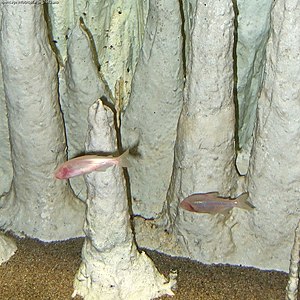Astyanax jordani
| Astyanax jordani | ||||||||||||
|---|---|---|---|---|---|---|---|---|---|---|---|---|

Astyanax jordani the blind cave tetra |
||||||||||||
| Systematics | ||||||||||||
|
||||||||||||
| Scientific name | ||||||||||||
| Astyanax jordani | ||||||||||||
| ( Hubbs & Innes , 1936) |
Astyanax jordani is a blind cave tetra from the family of the real tetras (Characidae). It is one of possibly only two eyeless species from the Astyanax fasciatus group. It is a freshwater fish up to 10 cm in length.
Name and identity
Originally the species was described as Anoptichthys jordani , but for a time it was only viewed as a blind cave form of the aboveground species Astyanax mexicanus , which in turn was only considered to be a subspecies A. fasciatus mexicanus . Sometimes the status of the blind cave shape was accepted as a subspecies ( A. mexicanus jordani ). Even in today's times with genetic testing possibilities, there are several views: According to Ornelas-García et al. (2008), who analyzed mainly mitochondrial DNA , but also a single cell nucleus gene, we are dealing with two species in the blind cave tetras. The Panuco-Tuxpan forms are assigned by the authors to A. jordani (this also includes the taxon Anoptichthys antrobius Álvarez, 1946 from the El Pachon cave) and the second type, which summarizes the Sabinos-Aguanaval-Mezquital forms, they include A . hubbsi too. Strecker et al. (2011) analyzed not only mitochondrial DNA but also microsatellite loci and came to the conclusion that the Mexican cave shapes only represent one species, which must be called A. jordani . In contrast, Dowlings et al. (2002) found out that the formation of cave shapes must have happened several times independently of one another.
distribution
The species is known from underground waters of forested mountain regions in southeastern San Luis Potosí in Mexico , such as B. the Chica Cave , Molino Cave and Pachon Cave . If one adds the distribution area of the taxon A. hubbsi , the distribution extends to the area of the Sabinos, Aguanaval and Mezquital caves.
features
Typical tetra shape. As with most cave fish , the pigments in A. jordani can be almost completely regressed, making the animals appear white. The eyes of these tetras have completely regressed due to the life in lightless waters. However, not all caves are completely without light, which is why there are gradual gradations in the extent of pigment and eye reduction. Tetras from the Sabinos, Tinaja, Pachón and Yerbaniz caves are completely white and have severely receded eyes. Fish from Caballo Moro, the Chica and Micos caves show a variable reduction in pigments and eyes.
literature
- Borowsky, R. (2008): Restoring sight in blind cavefish. Current Biology , 18 (1): R23-4. [1]
Individual evidence
- ↑ Hubbs, CL & WT Innes (1936): The first known blind fish of the family Characidae: a new genus from Mexico. Occasional Papers of the Museum of Zoology University of Michigan , 342: 1-7. ( PDF )
- ↑ Ornelas-García, CP, Domínguez-Domínguez, O. & Doadrio, I. (2008): Evolutionary history of the fish genus Astyanax Baird Girard (1854) (Actinopterygii, Characidae) in Mesoamerica reveals multiple morphological homoplasies. BMC Evol. Biol. , 8 (2008): 340
- ↑ Álvarez, J. (1946): Revisión del género Anoptichthys con descripción de una especie nueva (Pisc., Characidae). Anales de la Escuela Nacional de Ciencias Biologicas México , 4 (2-3) (1945): 263-282.
- ^ Strecker, U., B. Hausdorf & H. Wilkens (2011): Parallel speciation in Astyanax cave fish (Teleostei) in Northern Mexico. Molecular phylogenetics and evolution , doi : 10.1016 / j.ympev.2011.09.005 .
- ^ Dowling, TE, DP Martasian & WR Jeffery (2002): Evidence for Multiple Genetic Forms with Similar Eyeless Phenotypes in the Blind Cavefish, Astyanax mexicanus , Molecular Biology and Evolution , 19 (4): 446-455.
- ↑ Wilkens, H. & U. Strecker (2003): Convergent evolution of the cavefish Astyanax (Characidae, Teleostei): genetic evidence from reduced eye-size and pigmentation. Biological Journal of the Linnean Society , 80 (4): 545-554.
Web links
- Astyanax jordani on Fishbase.org (English)
- Astyanax jordani inthe IUCN Red List of Threatened Species 2020.1. Posted by: Ornelas García, P., 2018. Accessed April 13, 2020.